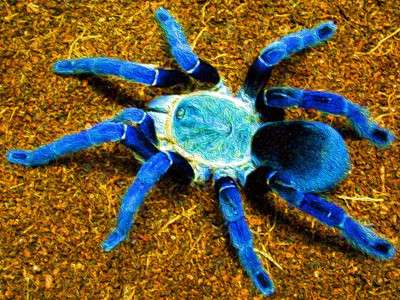
Aphonopelma seemanni, also called the striped-knee tarantula or Costa Rican zebra tarantula, is a species of tarantula that lives in Honduras, Nicaragua, and maybe Guatemala as well as most of western Costa Rica. The spider comes in a variety of colors, including brown. Its typical appearance is black with white stripes at the leg joints.
A medium-sized black spider with white stripes, the zebra tarantula is black in color. White stripes running vertically can be seen on their eight long legs. Because the stripes cross across their knee joints, they are also referred to as striped knee tarantulas. The zebra tarantula, sometimes known as the Costa Rican tarantula, is a native of Central America. These hairy tarantulas can measure 4-5 inches in length.
Physical Appearance
Legs and Coloration
The legs of the zebra tarantula are white with vertical stripes along their length. Setae, which are long brownish bristles that cover it, give it a furry appearance. Some are more brown than black, depending on color variation, but they all have the distinctive white stripes.
Abdomen and Cephalothorax
The huge abdomen and cephalothorax are the two body portions of these creatures. Two spinnerets are at the back, while the hair-covered chelicerae and pedipalps are in the front. The pedipalps are grabbing appendages, despite appearing to be extra legs. The males also make use of these when mating.
Leg span
Female zebra tarantulas can have a leg span of 4-5 inches and are larger than males. The males are slightly less stocky and smaller than the females.

Habitat
In Costa Rica, Honduras, and Nicaragua in Central America, zebra tarantulas can be found. They are a type of burrowing spider that enjoy digging large, deep holes in the ground, where they may occasionally spend months at a time. They are adapted to hot climates and can live in scrublands and dry woods. Their tunnels’ entrances are covered in webbing, which warns them of nearby movement and keeps them safe.
Feeding Habits
Insects, crickets, grasshoppers, roaches, tiny lizards, and mice are also prey items for zebra tarantulas. They are capable of going months at a time without eating. They bite their victim to release poison that stuns it when they do feed. The catch is then wrapped in a web and liquefied with digestive enzymes to the ideal drinking consistency.
Lifespan
The average lifespan of a girl is about 20 years, whereas that of a male is only eight to ten years. Males must exercise caution while mating because females will consume them if they remain too long. Even if a man is saved, he still passes away a few weeks or months later.
Reproduction
The male zebra tarantula must emerge from his burrows during mating season. He stops at a burrow and taps his leg on the ground outside the entryway as he looks for a receptive female. If the female emerges, the male will spin a sperm web, scatter his sperm on it, and then transmit it to the female’s abdominal orifice.
The female goes back to her burrow and can produce 50–1000 eggs there. She uses webbing to make an egg sac for the developing eggs. The spiderlings hatch after six to eight weeks and scurry about the hole. Before they leave the mother’s care, they will remain under her supervision for a few more days.
Keeping as Pet
Your spider’s habitat should be kept between 70 and 85 degrees Fahrenheit (21 to 30 degrees Celsius) and 75 to 80 percent humidity. Unless you keep your residence cool, more heat is typically not required. Generally speaking, tarantulas don’t require any grooming assistance from you. In essence, they groom themselves through molting. And as long as you limit stress and maintain the right temperature and humidity in their environment during this time, they ought to be able to molt without any problems.
Table





